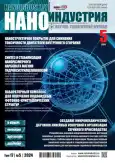Разработка широкопольного сканера-профилометра и новых способов измерения твердости для первого в мире атомно-силового микроскопа – спутника Земли
- Авторы: Логинов Б.А.1,2,3,4, Беспалов В.А.1, Образцов А.Н.5, Логинов А.Б.1,5,6, Логинов В.Б.1,6, Хрипунов Ю.В.7,8, Щербина М.А.7,8, Севостьянова Д.А.7, Богданова Д.С.7, Горбачев Р.Г.7, Кондратьева К.Е.7, Лебедева М.А.7, Мульгин А.А.7, Шевченко Д.А.7
-
Учреждения:
- Национальный исследовательский университет МИЭТ
- Образовательный центр "Сириус" Зеленоград
- Федеральная территория "Сириус"
- МГУ имени М.В.Ломоносова, физический факультет
- АО "Завод ПРОТОН"
- Образовательный центр "Сириус"
- Орловский государственный университет имени И.С. Тургенева
- Выпуск: Том 17, № 5 (2024)
- Страницы: 248-258
- Раздел: Оборудование для наноиндустрии
- URL: https://journals.eco-vector.com/1993-8578/article/view/635260
- DOI: https://doi.org/10.22184/1993-8578.2024.17.5.248.258
- ID: 635260
Цитировать
Полный текст
Аннотация
Предложена и проработана новая конструкция сканера для атомно-силового микроскопа-спутника, предназначенного для работы в течение нескольких лет в автономном режиме в открытом космосе с целью исследования орбит на содержание микро- и наночастиц пыли на базе профилометра в качестве одной из осей сканирования. Микроскоп с данным сканером рассчитан и проверен на стойкость к перегрузкам до 50g при запуске, энергопотреблению не более 1 Вт от солнечных батарей, устойчив к потокам быстрых ионов солнечной плазмы, имеет большое поле сканирования открытого на космос зеркала для обнаружения и исследования попадающих на него частиц даже при малом их количестве. Показано, что применяемый в профилометрах индуктивный датчик с линейным приводом на длину в десятки миллиметров дорабатывается до разрешения в 1 нм, как по высотам рельефа за счет уменьшения магнитного зазора, так и по латерали за счет использования сверхострых алмазных игл с острием из нескольких атомов на конце. Применение второго линейного привода для второй координаты обеспечивает сканирование строчка за строчкой больших площадей с нанометровой точностью до 10 Гигапикселей, при этом сканирование одного кадра за несколько суток вполне допустимо для космического эксперимента, длящегося несколько лет в автономном режиме. При выборе материала зеркала микроскопа разработаны новые способы измерения твердости объемных материалов и тонких пленок, имеющие ряд принципиальных преимуществ и не требующие каких-либо других приборов при наличии профилометров или зондовых микроскопов. Изготовлены и испытаны макеты основных узлов нового сканера, которые показали его принципиальную работоспособность и позволили приступить к патентованию и изготовлению летной версии автономного космического атомно-силового микроскопа, претендующего на звание "первого в мире".
Полный текст
Об авторах
Б. А. Логинов
Национальный исследовательский университет МИЭТ; Образовательный центр "Сириус"Зеленоград; Федеральная территория "Сириус";
Автор, ответственный за переписку.
Email: b-loginov@mail.ru
ORCID iD: 0000-0001-5081-1424
нач. лаб., рук. проекта
Россия, АО "Завод ПРОТОН"; ЗеленоградВ. А. Беспалов
Национальный исследовательский университет МИЭТ
Email: b-loginov@mail.ru
ORCID iD: 0000-0003-4976-8515
чл.-корр. РАН, доктор технических наук, ректор
Россия, ЗеленоградА. Н. Образцов
МГУ имени М.В.Ломоносова, физический факультет
Email: b-loginov@mail.ru
ORCID iD: 0000-0001-8017-0496
доктор физико-математических наук, профессор
Россия, Москва
А. Б. Логинов
Национальный исследовательский университет МИЭТ; МГУ имени М.В.Ломоносова, физический факультет; АО "Завод ПРОТОН"
Email: b-loginov@mail.ru
ORCID iD: 0000-0003-2090-5301
аспирант
Россия, Зеленоград; Москва; ЗеленоградВ. Б. Логинов
Национальный исследовательский университет МИЭТ; АО "Завод ПРОТОН"
Email: b-loginov@mail.ru
ORCID iD: 0000-0002-2116-7411
ведущий конструктор
Россия, Зеленоград; ЗеленоградЮ. В. Хрипунов
Образовательный центр "Сириус";Орловский государственный университет имени И.С. Тургенева
Email: b-loginov@mail.ru
ORCID iD: 0000-0003-2250-0420
кандидат физико-математических наук, доцент
Россия, Федеральная территория "Сириус"; ОрелМ. А. Щербина
Образовательный центр "Сириус";Орловский государственный университет имени И.С. Тургенева
Email: b-loginov@mail.ru
ORCID iD: 0009-0001-8873-4986
студент
Россия, Федеральная территория "Сириус"; ОрелД. А. Севостьянова
Образовательный центр "Сириус"
Email: b-loginov@mail.ru
ORCID iD: 0009-0005-0496-6755
стажер
Россия, федеральная территория "Сириус"Д. С. Богданова
Образовательный центр "Сириус"
Email: b-loginov@mail.ru
ORCID iD: 0009-0002-7532-4678
студент
Россия, федеральная территория "Сириус"Р. Г. Горбачев
Образовательный центр "Сириус"
Email: b-loginov@mail.ru
ORCID iD: 0009-0007-0435-6847
студент
Россия, федеральная территория "Сириус"К. Е. Кондратьева
Образовательный центр "Сириус"
Email: b-loginov@mail.ru
ORCID iD: 0009-0009-9965-7750
студент
Россия, федеральная территория "Сириус"
М. А. Лебедева
Образовательный центр "Сириус"
Email: b-loginov@mail.ru
ORCID iD: 0009-0001-9070-3505
студент
Россия, федеральная территория "Сириус"
А. А. Мульгин
Образовательный центр "Сириус"
Email: b-loginov@mail.ru
ORCID iD: 0009-0005-7847-7137
студент
Россия, федеральная территория "Сириус"Д. А. Шевченко
Образовательный центр "Сириус"
Email: b-loginov@mail.ru
ORCID iD: 0009-0009-8866-0268
Student
Россия, федеральная территория "Сириус"
Список литературы
- Беспалов В.А., Логинов Б.А., Новиков Л.С., Никитушкина О.Н. Исследование ударной микроструктуры на поверхности медной пластины, экспонировавшейся в открытом космосе. Физика и xимия обработки материалов. 2008. № 2. С. 28–31.
- Логинов Б.А. Комплекс зондовой микроскопии для работы в космическом пространстве и атмосфере. Патент на изобретение 2778278 C1, 17.08.2022, Заявка № 2021128836 от 04.10.2021.
- Логинов Б.А. Первый в мире сканирующий зондовый микроскоп в виде спутника как старт этапа научных спутников-лабораторий. НАНОИНДУСТРИЯ. 2021. № 5. С. 22–26. https://doi.org/ 10.22184/1993-8578.2021.14.5.270.274
- Логинов Б.А., Хрипунов Ю.В., Щербина М.А., Вьюник А.О., Дмитриева В.Д., Дьякова А.А., Лебедева М.К., Макеев В.С., Первых А.Р., Шевченко Д.С., Ханин С.Д. Наблюдение изменения морфологии пленок высокотемпературных металлов в сканирующем зондовом микроскопе при прогреве в условиях открытого космоса. НАНОИНДУСТРИЯ. 2024. № 2. С. 90–97. https://doi.org/10.22184/1993-8578.2024.17.2.90.9
- Логинов Б.А., Логинов П.Б., Логинов В.Б., Логинов А.Б. Зондовая микроскопия: применения и рекомендации по разработке. НАНОИНДУСТРИЯ. 2019. № 6. C. 352–365. https://doi.org/10.22184/1993-8578.2019.12.6.366.369
- Левин К.Л., Беспалова Е.А., Ванькаев А.С., Клюкина Е.В., Лопатин А.В., Метальников Н.М., Сапрыкин М.Э., Логинов А.Б., Оразов И.В., Логинов Б.А. Изучение изменения морфологии поверхности многослойных графеновых структур при воздействии плазмой в качестве модели солнечного ветра в открытом космосе // Международный журнал прикладных и фундаментальных исследований. 2021. № 9. С. 51–55.
- Елкин А.Г., Логинов Б.А., Логинов В.Б., Троян В.И. Устройство прецизионного перемещения. Патент на изобретение RU 2537363 C2, 10.01.2015, Заявка № 2013107665/11 от 21.02.2013.
Дополнительные файлы












